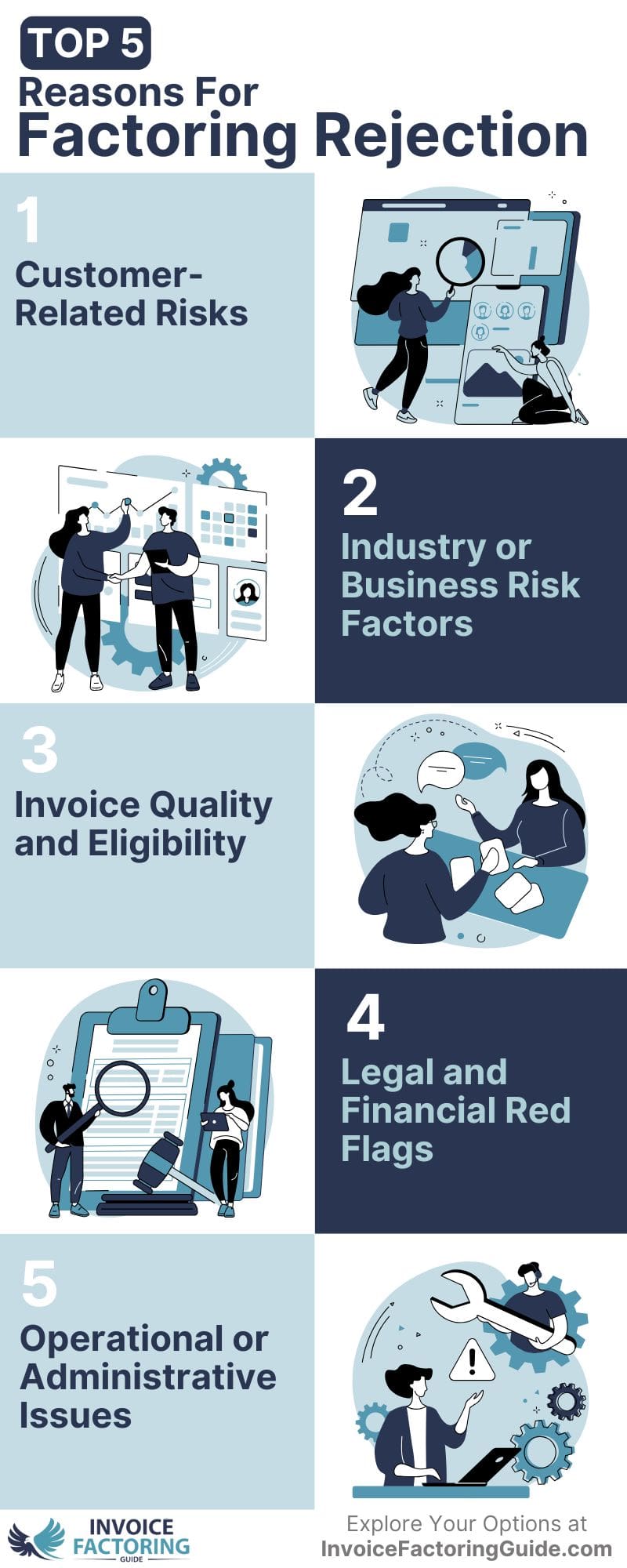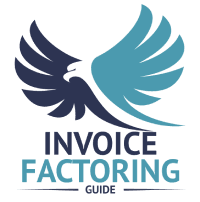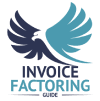
Are you worried about denials, or was your factoring application rejected? Even though the factoring approval process is usually easy, sometimes businesses do hit roadblocks along the way. In this guide, we’ll explore why factoring applications get rejected and what you can do about it if you’re impacted.
Top Reasons for Factoring Rejection

If your factoring application is rejected, it typically reflects perceived risk, either in your customer base, your invoicing process, or your company’s operational structure. Below, we’ll explore some of the most common factoring denial reasons.
1. Customer-Related Risks
- Poor Customer Credit Profiles: Factoring companies prioritize your customers’ creditworthiness over your own. They run credit checks on your customers If your clients have a history of late payments, defaults, or bankruptcy, it signals a high likelihood of delayed or missed payments.
- Customer Concentration: If a small number of your clients represent a large percentage of your total receivables, it’s referred to as having a high customer concentration. The factoring company may view your business as vulnerable to disruption if that client defaults or delays payment.
2. Industry or Business Risk Factors
- High-Risk Industries: Businesses in high-risk industries like construction, medical receivables, or staffing may face additional scrutiny. These industries often involve complex contracts, progress billing, or frequent disputes that complicate the factoring process.
- Lack of Business History: Startups and newly formed entities are sometimes declined because they lack the documentation, systems, and client relationships that provide factoring companies with confidence.
3. Invoice Quality and Eligibility
- Disputed or Unverifiable Invoices: Factoring requires clear, legitimate, and uncontested invoices. If your invoices are frequently disputed or missing supporting documentation like purchase orders or delivery confirmations, your application may be rejected.
- Non-Assignable Contracts: Some contracts prohibit the assignment of receivables to a third party. If your client agreements include these terms, those invoices cannot be factored.
4. Legal and Financial Red Flags
- Outstanding Liens or Uniform Commercial Code (UCC) Filings: Factors check for UCC filings as part of the approval process. If another lender already holds a claim to your receivables, the factoring company may be unable to proceed without a subordination agreement.
- Legal Judgments or Tax Issues: Open tax liens, lawsuits, or judgments against your business raise concerns about your financial stability and may prevent approval.
5. Operational or Administrative Issues
- Inadequate Recordkeeping: Factoring companies require reliable records to verify that invoices are accurate and enforceable. Disorganized or inconsistent documentation can undermine confidence in your ability to support the funding process.
- Missing Business Insurance: In some industries, lacking proper general liability or commercial insurance may disqualify your business from funding.
Steps to Take After Factoring Rejection
Think of a factoring rejection as a diagnostic rather than a dead end. Use it to fine-tune your operations, improve your eligibility, and ultimately partner with a funder who understands your business model.
Step 1: Ask for Specific Feedback from Factors

- Confirm the Application was Denied: If you had application gaps or missing information, you might have received a soft denial rather than a firm rejection. If details or documents were missing, you can usually just submit them and continue where you left off in the process.
- Request a Clear Explanation: Contact the factoring company directly and ask for the exact reason your application was declined. Understanding whether the issue was related to your customers, documentation, or internal operations will help you address it effectively.
- Clarify the Scope of the Rejection: Confirm whether the decision applies to your entire business or only specific invoices or clients. In some cases, only part of your receivables may have been declined, which means limited funding may still be possible with adjustments.
Step 2: Strengthen and Diversify Your Customer Portfolio
- Assess Client Creditworthiness: Use a business credit reporting service like Dun & Bradstreet or Creditsafe to review your customers’ payment histories. If one or more of your clients are flagged as high risk, consider adjusting your terms or shifting your focus to more reliable accounts.
- Identify Concentration Risk: Look at the percentage of revenue each customer represents. Even if no single client seems dominant, a small client base can still create exposure. For example, if you have ten clients, each representing ten percent of your receivables, just one or two missed payments could create a serious cash shortfall.
- Take Steps to Reduce Reliance: Expand your client base, even incrementally. Adding two or three additional customers can significantly reduce overall risk exposure. If acquiring new customers takes time, consider rebalancing work toward clients with stronger credit to reduce dependency on any one relationship.
- Prepare a Diversification Plan: If your business is still growing, include a brief note with your next application that outlines your diversification goals. Some factoring companies are more flexible when they see you’re proactively managing risk and have a plan in place.
Step 3: Examine Your Invoicing Process
- Check for Assignment Restrictions: Review your contracts to confirm that your receivables can legally be assigned to a factoring company. If needed, negotiate updated terms for future agreements.
- Ensure Invoices Are Clear and Verifiable: Each invoice should reference a signed contract or purchase order, include delivery or service confirmation, and match what the customer expected. Avoid vague line items or inconsistent formatting and ensure invoice accuracy.
- Use Professional Accounting Software: Platforms like QuickBooks, Xero, or FreshBooks can help you generate standardized, trackable invoices and maintain organized records. This improves transparency and builds trust with factoring companies reviewing your documentation.
Step 4: Address Legal and Financial Barriers
- Resolve Open Liens or Judgments: If your receivables are tied up by a lender or tax authority, work with that entity to obtain a subordination agreement or settle the issue entirely.
- Update UCC Filings if Appropriate: Sometimes a former lender has a UCC filing that should have been released. Follow up to ensure that outdated claims are removed from public records.
Step 5: Strengthen Operational Readiness
- Organize Your Financial Records: Factoring companies want to see clean documentation, including your accounts receivable aging reports, tax filings, and proof of service or delivery. Investing in professional bookkeeping can make a difference.
- Secure Necessary Insurance Coverage: If you operate in a field where commercial liability insurance is expected, make sure your policy is current and adequate.
Step 6: Reapply Strategically or Find a Better Fit
- Correct and Reapply: If you have resolved the specific issues mentioned in the rejection, you can often reapply with the same company within a few weeks or months.
- Explore Specialized Providers: If your rejection was due to industry-specific challenges, seek out factoring companies that specialize in your field. For example, some providers focus exclusively on construction, staffing, or transportation receivables.
Step 7: Consider Alternative Financing Options and Business Cash Flow Solutions
- Explore Other Financing Solutions: If factoring is not currently an option, look into short-term financing tools such as merchant cash advances, business lines of credit, or revenue-based loans. While these come with different risks and costs, they may serve as a temporary bridge while you address the issues that led to rejection.
- Negotiate Better Payment Terms: Work with customers to shorten payment cycles where possible. Even a shift from Net 60 to Net 30 can significantly improve cash flow over time. Incentives like small early payment discounts can help encourage faster payments.
- Adjust Your Billing Practices: Invoice immediately upon delivery of goods or completion of services. Delays in sending invoices compound cash flow problems and give the impression of poor financial controls.
- Improve Collections Efficiency: Establish clear follow-up processes for unpaid invoices. Automate reminders or assign a team member to follow up at regular intervals. The more consistently you collect, the stronger your cash position will become, even without outside funding.
- Connect with an Advisor: Working with financial advisors after a factoring rejection can also help. They can provide a full financial profile review that will help you shore things up. They can also help you with identifying gaps in your factoring application and show you how to analyze feedback from a factoring company.
Find a Factor Who Can Help
Choosing the right factoring company for your business isn’t always easy, especially if you’re worried about denials or have already been rejected. Our network of vetted factors includes specialists who work with businesses across a wide variety of industries and even focus on certain high-risk sectors that others shy away from. If you’re serious about finding better financing opportunities for small businesses, don’t let the fear of a denial block your path to funding. Let us match you with experts who want to help. Request a free rate quote to get started.
FAQs on What to Do if Your Factoring Application is Rejected
What are some factoring alternatives if I’m rejected?
If factoring is not an option, consider alternatives like business lines of credit, merchant cash advances, or short-term loans. You might also renegotiate payment terms with clients or implement stronger collections practices to improve cash flow while you work toward becoming factoring-ready.
How can I improve factoring approval odds?
To increase your chances of approval, verify that your invoices are clear and undisputed, strengthen your customer base, and maintain organized financial records. Reducing customer concentration and resolving any legal or financial issues can also help position your business more favorably with factoring companies.
Where can I get help exploring financing alternatives for rejected applicants?
Start by using platforms like Invoice Factoring Guide, which can help match your business with factoring companies more aligned with your industry, risk profile, or customer base. You can also consult a commercial loan broker or funding advisor who specializes in alternative lending options.
How do I go about comparing factoring alternatives for cash flow needs?
Start by evaluating the speed, flexibility, and cost of each option. Look at repayment terms, required collateral, and how well the funding aligns with your invoicing cycle. It’s helpful to use a side-by-side comparison or consult with a funding advisor to match solutions to your specific goals.
How can I improve my creditworthiness for factoring?
Although your personal or business credit is not the primary factor, knowing how to strengthen your creditworthiness for factoring approval can still help. Pay down outstanding debts, resolve liens or judgments, and maintain updated records. These steps help show that your business is financially stable and operationally reliable. For more information on the process, review our Factoring Guide.
Will applying for factoring hurt my credit or cause problems if I get denied?
Most factoring companies do not perform hard credit checks, and your customers’ credit matters more than yours. A denial will not affect your credit score or create legal complications. The process is typically low risk, and applying is a smart way to explore your funding options, even if you are unsure.
Why would a factoring company turn me down if my business is doing well?
Factoring companies focus on your customers’ ability to pay, not your revenue or growth. You may be declined if your clients have poor credit, your invoices are disputed or non-assignable, or your records are incomplete, even if your business is profitable and well-managed.
Can I still get funding if a factoring company rejected me?
Yes. A rejection from one factoring company does not mean you are out of options. You may qualify with a different provider that specializes in your industry or situation. You can also explore other funding sources like short-term loans, lines of credit, or merchant cash advances.
How soon can I reapply after a factoring rejection?
You can often reapply as soon as the issue that caused the rejection is resolved. This may mean updating paperwork, removing a lien, or improving invoice quality. Some providers will consider a revised application within weeks, while others may require a longer waiting period.
Do I need perfect customers to qualify for invoice factoring?
No, but your customers do need to be reasonably creditworthy. Factoring companies review their payment history, credit ratings, and risk profile. One or two weaker clients may not disqualify you, but a consistently risky customer base can affect your approval odds or funding limits.
What should I do if factoring is my only option and I was denied?
Start by understanding why your application was rejected. In some cases, making small changes, like improving documentation or adjusting customer mix, can make you eligible. Then, use Invoice Factoring Guide to explore factoring companies that may be a better fit for your situation. Some providers specialize in startups, high-risk industries, or clients with concentrated portfolios. You may still qualify elsewhere with the right match.

About Invoice Factoring Guide
Related Insights
Get an instant funding estimate
Results are estimates based on the calculated rate and the total invoice amount provided.
Actual rates may vary.
Request a Factoring Rate Quote
PREFER TO TALK? Call us at 1-844-887-0300










